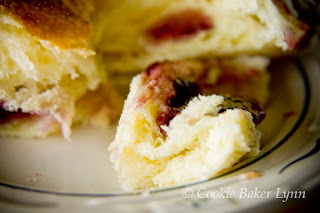
I come from the land of deep powder and I don't ski. I learned as a child, but I never enjoyed it. All of my skiing memories are ones of discomfort and fear, so when I reached the age when it was my choice rather than my parents', I said no. And no it stayed until I was a senior in high school.
My best friend persuaded me to go skiing with her. This was a bad idea on several counts. One being that I'm a really bad, cowardly skier. Two being that, despite her protests to the contrary, I was fairly certain that she was quite a good skier. And three being that she was drop dead gorgeous. It was difficult going anywhere in public with her.
Despite my huge misgivings, we went skiing. She promised me a super simple run. I should have known it was trouble when it was a chair lift with a transfer. When we unloaded I was in deep trouble. If not for my friend, I would have stayed on the chair lift and ridden it back down the mountain.
She stayed with me for a few easy, gentle runs, waiting for me at the bottom of each slope. Each time I caught up with her, there would be at least one handsome man trying to make her acquaintance. I think the idea was dawning in her mind that I had not exaggerated my lack of skiing ability and this was going to be a very tedious day. So on the next slope she skied merrily away and disappeared over the edge.
If I had a soundtrack to my life, this would be the part where the ominous music played. I cautiously approached the edge, looked over, and saw, Holy Freaking Cow!, moguls! Big moguls! Guess what, bunny slope snow plow turns don't work well on moguls. I did my best for the top quarter of the slope, then fell and slid to the middle of the slope, one ski off and my poles completely beyond reach. I sat crying, inching my way over to get my ski and poles, doing my best to avoid flying mogul pounders, and I looked around to find my friend.
I saw her. At the bottom of the run, surrounded by tall handsome men. They'd all gone flying by me as I sat snow-covered and distressed, but surrounded my friend because she looked worried. Hmmmph. Sometimes that's the way life is when you're out of your league.

Recently I got a note from the fabulous Tanna of My Kitchen In Half Cups. She asked me if I'd be interested to join a group of bakers exploring bread making. Letmethink-yes! But I was worried that I was out of my league. All the other bakers are fabulous! But sometimes, to improve, you've got to run with the big dogs. Or bake with the Babes. The Bread Baking Babes that is. So I joined and am trying to keep up as we boldly explore the world of bread and, specifically this month, the Royal Crown Tortano.
This is a very different bread from the kind I normally make. It has barely any yeast, has a dough as wet as glue and a really slow rise time, bakes to almost black in the oven, and is supposed to have pockety holes in the bread. I felt good about the pre-ferment. In the morning it was all bubbly, just like it was supposed to be, but after the folding stage I kept waiting for the dough to expand and it just sat there.

Having never made this dough before I had no idea of what it was supposed to feel like. Bread making is very tactile and written instructions are helpful, but not as good as experience. I formed my ring, set it to rise, did the complicated transfer to the oven, and watched it get darker and darker, but never much taller at all.
It had quite a crust, but was a tad on the gummy side inside. Fortunately for me, my family loves dipping bread in olive oil and balsamic vinegar and didn't complain a bit about the texture.
Now, I was out of my comfort zone (and out of my league) making this bread. But the other bakers didn't sit on the sidelines and fire snide comments about my oddly flat bread. They had helpful suggestions about what might have caused the problem and gave me enough confidence to try making the bread again. I think, in the main, my kitchen is too chilly to make the yeasties happy, and when I made the rising dough a little warmer, it performed better.
I never went skiing with my friend again, but I will definitely be baking with this great group again!

Check out their successes with the Crown here:
A Fridge Full of Food (Glenna),
Bake My Day (Karen),
Cookie Baker Lynn (Lynn),
I Like to Cook (Sara),
Living on Bread and Water (Monique),
Lucullian Delights (Ilva),
My Kitchen in Half Cups (Tanna),
Nami-Nami (Pille),
Notitie van Lien (Lien),
The Sour Dough (Mary aka Breadchick), and
What Did You Eat (Sher)If you'd like to be a Bread Baking Fan and try your hand at this fun and challenging bread, make it, blog it, and send a link to
commentmykitchen@mac.com. There will be a roundup of all the Bake-Alongs next week.
Royal Crown's Tortano(from
Artisan Baking Across Americao by Maggie Glazer)
Recipe Quantity: One (1) 2 1/4lb (1200 gram) tortano
Time Required for Recipe: About 19 hours, with about 20 minutes of active work
Note about recipe: You will need to start this recipe the night BEFORE you want to bake the bread.
This is the most beautiful bread Royal Crown makes, a huge round loaf filled with radish size air cells, tanks to careful handling and lots of water in teh dough. Joe adds potato for flavor and moistness and honey for color to this very wet, squichy dough. For extra flavor, the bread is leavened solely by its starter, so it rises very slowly and develops a nice but not aggressive acidity. To get authentic Italian flavor, you will need to bake this bread to a deep, dark brown so don't skimp on the baking time - the bread will not burn.
Recipe Synopsis
The Evening Before Baking: Make the starter and if you like the mashed potato.The Next Morning: Mix the dough and let it ferment for about 4 hours. Shape it, proof it for about 1 1/2 hours, and then bake the bread for about 45 minutes.
The Evening Before Baking: Making the Pre-Ferment:
Ingredients Volume (English units)
1/4 tsp instant yeast
1 cup water 105 - 115 degrees F
2/3 cup unbleached bread flour
1 small potato
Ingredients Weight
1/4 tsp instant yeast
1 cup water 105 - 115 degrees F
3.5 ounces unbleached bread flour
3 ounce small potato
Ingredients Metric
1/4 tsp instant yeast
1 cup water 105 - 115 degrees F
100 grams unbleached bread flour
85 grams small potato
Ingredients Baker's Percentages
eventually 0.3% instant yeast
eventually 73% water 105 - 115 degrees F
100% unbleached bread flour
1 small potato
Stir the yeast into the water in a glass measure and let it stand for 5 - 10 minutes. Add 1/3 cup of this yeasted water (discard the rest) to the flour and beat this very sticky starter until it is well combined. Cover with plastic wrap and let it ferment until it is full of huge bubbles and sharp tasting, about 12 hours. If your kitchen is very warm and the pre-ferment is fermenting very quickly, place it in the refrigerator after 3 hours of fermenting. In the morning, remove it and allow it to come to room temperature 30 minutes to an hour before beginning the final dough
Preparing the Potato: For efficiency, you may want to prepare the potato the night before. Quarter it, then boil it in water to cover until it can be easily pierced with a knife tip, about 20 minutes. Drain; if desired, reserve the water for the dough. Press the potato through a ricer or sieve to puree it and remove the skin. Store it in a covered container in the refrigerator. You will need only 1/4 cup puree.
Bake Day: Mixing the Dough
Ingredients Volume (English units)
3 3/4 cups unbleached bread flour
1 3/4 cups plus 3 Tbsp Water, including the potato water if desired, lukewarm
Pre-ferment
2 tsp honey
1/4 cup packed Potato puree
1 Tbsp salt
Ingredients Weight
20 ounces unbleached bread flour
14.6 ounces Water, including the potato water if desired, lukewarm
Pre-ferment
0.4 ounces honey
2 ounces Potato puree
0.5 ounces salt
Ingredients Metric
575 grams unbleached bread flour
420 grams Water, including the potato water if desired, lukewarm
Pre-ferment
14 grams honey
60 grams Potato puree
15 grams salt
Ingredients Baker's Percentages
100% unbleached bread flour
73% Water, including the potato water if desired, lukewarm
30% Pre-ferment
2% honey
10% Potato puree
2.4% salt
By Hand: Use your hands to mnix the flour and water into a rough, very wet dough in a large bowl. Cover the dough and let rest (autolyse) for 10 - 20 minutes.
Add the pre-ferment, honey, potato, and salt, and knead the dough until it is smooth, 5 - 10 minutes. It will start off feeling rubbery, then break down into goo; if you persist, eventually it will come together into a smooth, shiny dough. If you do not have the skill or time to knead it to smoothness, the bread will not suffer. This is a tremendously wet and sticky dough, so use a dough scraper to help you but do not add more flour, for it will ruin the texture of the bread.
By Stand Mixer: With your hands or a wooden spoon, mix the flour and water into a rough, very wet dough in the work bowl of your mixer. Cover the dough and let it rest (autolyse) for 10 - 20 minutes.
Fit the mixer with the dough hook. Add the pre-ferment, honey, potato and salt and the mix the dough on medium speed for 15 - 20 minutes, or until very silky and wraps around the hook and cleans the bowl before splaterring back around the bowl. This dough is almost pourably wet.
Fermenting and Turning the Dough:
Shape the dough into a ball and roll it in flour. Place it in a container at least 3 times its size and cover tightly with plastic wrap. Let it ferment until doubled in bulk and filled with large air bubbles, about 4 hours. Using plenty of dusting flour, turn the dough 4 times in 20 minute intervals, that is, after 20, 40, 60, and 80 minutes of fermenting, the leave the dough undisturbed for the remaining time. Do not allow this dough to over ferment or forment to the point of collapse, for the flavor and structure of your bread will suffer.
Shaping and Proofing the Dough:
Turn the fermented dough out onto a well floured work surface, round it and let it rest for 20 minutes. Sprinkle a couche or wooden board generously with flour. Slip a baking sheet under the couche if you are using one for support.
Sprinkle a generous amount of flour over the center of the ball. Push your fingers into the center to make a hole, the rotate your hand around the hole to widen it, making a large 4 inch opening. The bread should have about 12 inch diameter.
Place the dough smooth side down on the floured couche or board and dust the surface with more flour. Drape it with plastic wrap and let it proof until it is light and slowly springs back when lightly pressed, about 1 1/2 hours.
Preheating the Oven:
Immediately after shaping the bread, arrange a rack on the oven's second to top shelf and place a baking stone on it. Clear away all the racks above the one being used. Preheat the oven to 450 degrees (230 C)
Baking the Bread:
Unwrap the bread and flip it onto a floured peel or a sheet of parchment paper. Do not worry about damaging the bread as you handle it; it will recover int eh oven as long as it is not overproofed. Slash it with 4 radial cuts in the shape of a cross. Slide the loaf onto the hot baking stone and bake until it is very dark brown, 40 -50 minutes, rotating it halfway into the bake. Let the bread cool on a rack.

 It took all day, but that's because of the long rise times that develop the flavor in the dough. There were some tricky steps, the most tricky for me being transferring my risen loaves to the hot oven onto the hot baking stone. When I was approaching that step I shrieked, "Ah, how am I supposed to get these into the oven without a baker's peel?"
It took all day, but that's because of the long rise times that develop the flavor in the dough. There were some tricky steps, the most tricky for me being transferring my risen loaves to the hot oven onto the hot baking stone. When I was approaching that step I shrieked, "Ah, how am I supposed to get these into the oven without a baker's peel?"  I was so excited to watch the bread rise and crust up nicely. Honestly, it's better than TV, watching a happy loaf of bread bake!
I was so excited to watch the bread rise and crust up nicely. Honestly, it's better than TV, watching a happy loaf of bread bake! Now you might think I've put that gold star on my chart and moved on, but my husband said a few days later, "Do you think you could make that bread again? It was really good." Well how could I refuse my sweet, woodworking husband? So I made it again, only this time trying the longer loaves. Still fun, still good. And easier, now that I had more of an idea what I was doing and which part of the directions applied. I know I'll make this recipe again and again, because, like skydiving, the scariest part is just before you jump. Once you jump, it's a rush!
Now you might think I've put that gold star on my chart and moved on, but my husband said a few days later, "Do you think you could make that bread again? It was really good." Well how could I refuse my sweet, woodworking husband? So I made it again, only this time trying the longer loaves. Still fun, still good. And easier, now that I had more of an idea what I was doing and which part of the directions applied. I know I'll make this recipe again and again, because, like skydiving, the scariest part is just before you jump. Once you jump, it's a rush!



























